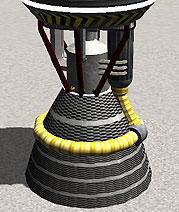Reaction engine
A reaction engine is an engine that generates thrust solely through the use of onboard propellant. Unlike jet engines, which require an oxygen-rich atmosphere to operate, rocket engines are able to function where no oxygen is present. If a reaction engine involves chemical combustion it is called a rocket engine.
Contents
[hide]Physics
All reaction engine work with the same principle: mass is propelled out of the nozzle which accelerates the vehicle due to Newton's third law of motion. Every engine in the game uses this basic principle, differing in the environments in which they will function (jet engines require an oxygen-rich atmosphere), the types of fuel they consume (ion engines require the vehicle to mount xenon tanks), and the game controls which activate them (RCS thrusters respond to directional controls, all others respond to the throttle).
Solid fuel rocket engines
- → Main article: Solid rocket booster
The most basic type is the solid fuel rocket, which is simply a solid, self-oxidizing compound or mixture within a casing with a nozzle at the rear to allow the gases produced to escape.
Advantages
- Very high thrust-to-weight ratio.
- Engine and fuel tank are combined in one part, lowering part count and simplifying design.
Disadvantages
- Cannot be throttled or switched off after ignition.
- Cannot be refueled or use fuel stored elsewhere on the craft.
- Low efficiency compared to other types of engines.
Liquid fuel rocket engines
Liquid fuel engines are powered by liquid fuel ignited with oxidizer. In the real world typical liquid fuels are liquid hydrogen or kerosene, and typical oxidizers are liquid oxygen or nitrous-oxide. All engines use Bell nozzles except the aerospike engine.
The LV-N Atomic Rocket Motor's real world inspiration, the NERVA, is not a liquid engine. The LV-N is one to simplify gameplay and Squad's development work.
Advantages
- Fuel and oxidizer can be moved between tanks. This opens many possibilities for fuel management and logistics, including replenishing the fuel supply of a craft already in flight.
- Engines and fuel need not be mounted in the same location on the ship, expanding design possibilities.
- Variable throttle allows different levels of thrust at different times, or for the engines to be shut down entirely and restarted later in the flight.
- Some liquid engines have gimbals which allows them to help steer the craft.
- Available in a wide range of thrusts and efficiencies, all of which may share fuel with each other.
Disadvantages
- Lower thrust-to-weight ratio compared to solid rocket engines.
- Separation of engine and fuel leads to increased part count for all except the KR-1x2.
Ion engines
An ion engine uses electricity to ionize atoms of xenon gas and accelerate them in an electrostatic or electromagnetic field to propel them as exhaust. Remarkably little xenon gas fuel is needed, but ion engines are very demanding on electrical generation and storage.
Advantages
- Extremely high efficiency, which is unaffected by atmosphere.
Disadvantages
- Extremely low thrust. Ion engines cannot be used to lift off from most celestial bodies, and most maneuvers will take tens of minutes to complete.
- High electric consumption.
- No thrust vectoring currently available.
RCS thrusters
RCS thrusters use their own fuel, monopropellant, and do not require a separate oxidizer. RCS is primarily used for steering a craft or making very small positional adjustments during docking; it is too weak and inefficient to function as a main maneuvering engine.
Advantages
- Monopropellant is automatically distributed throughout a vehicle and does not require crossfeeding to be manually set up.
Disadvantages
- Very low thrust. The available RCS thrusters are too weak to lift off from most celestial bodies.
- No thrust vectoring is available (however, the most commonly use thruster, the RV-105 RCS Thruster Block, can thrust in 4 directions).
- The user can only switch engines on or off, while the SAS can run them on different thrust levels in between.
- Low efficiency.
See also
- Reaction engine on Wikipedia
- Rocket engine on Wikipedia



































